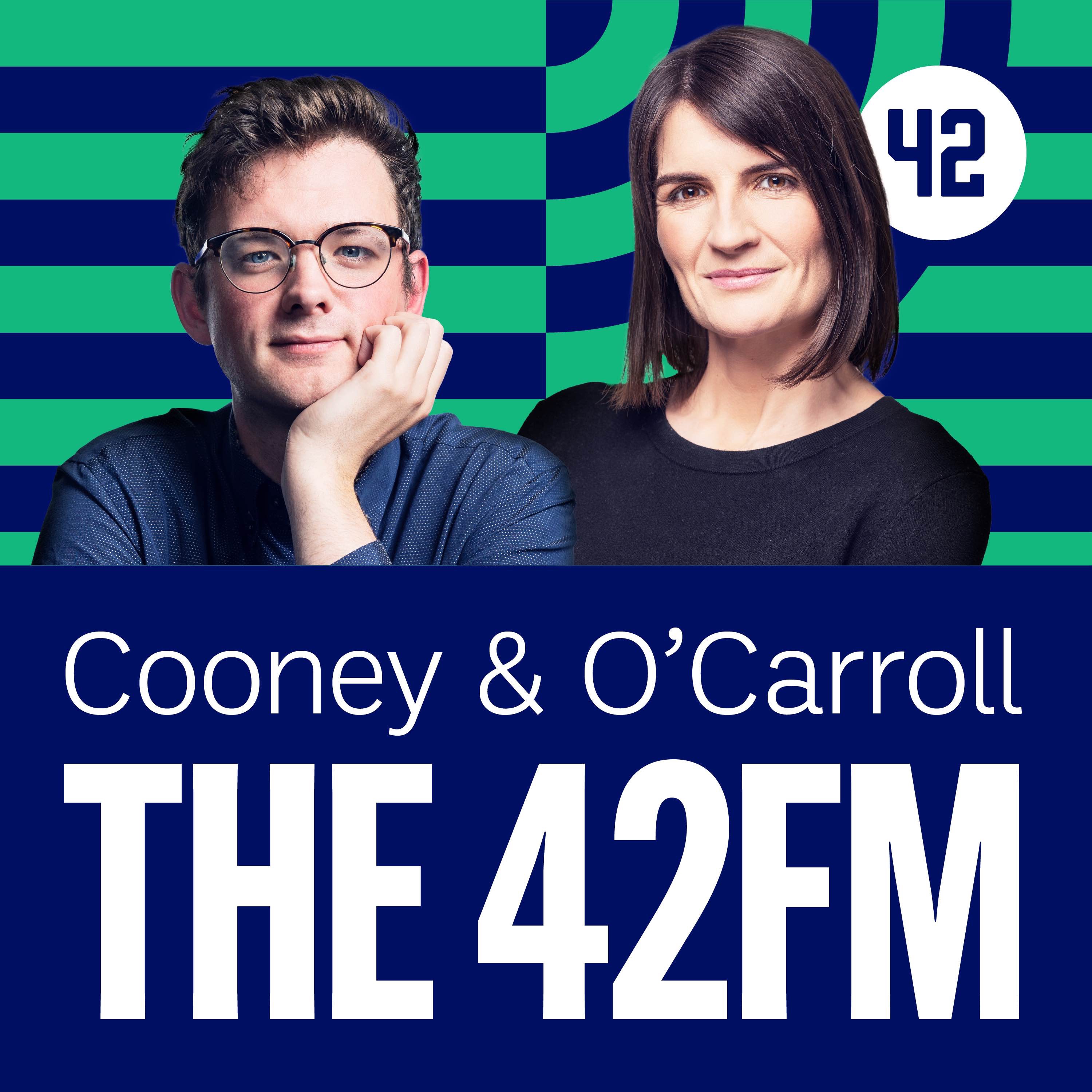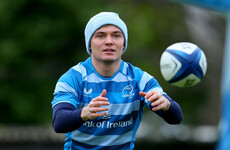This article is a part of 2000: Revisited, a week-long series of features looking back on some of the headlines and the forgotten stories that filled the sports pages 20 years ago.
Here, Sean Farrell follows a tune that came to prominence in Munster’s run to the 2000 Heineken Cup final and instantly became a hymn for all the brave and faithful.
22 OCTOBER 2016, just as the waters threatened to calm on the most tumultuous day of emotions that Thomond Park has seen – and it had been through a fair few of them – a hush comes over the crowd.
For the briefest moment it looks like bodies in the stand are disconnected from their team, merely watching on as athletes in red, men in suits, old warhorses in tracksuits and familiar-looking boys form a circle on the pitch. But as the hush turns to perfect respectful silence among 25,600 people, the lingering strength of the bond is revealed.
The players, regrouping after an angry grief-fuelled win over Glasgow Warriors, were singing their anthem. A rousing song they had heard flow from Anthony Foley’s voice hundreds of times before, but no more.
By the time the opening verse echoed faintly out from within the huddle and boots began to drum into grass, the crowd and the players were one again, bellowing out a thunderous chorus.
An incredibly moving, organic moment when warriors and their watchers sought out a link through a shared hymn. Stand Up and Fight.
No discussion was needed to agree on the song to suit the moment. It is squad ritual to gather and sing the old words with an older tune post-match in the dressing room. It has echoed across Europe from the mouths of the faithful. It is performed pre-match in Thomond Park to stir up anticipation for a gladiatorial duel. A quartet of former coaches sang it with the World Cup in their lap and the southern province’s social media missives are punctuated with the acronym #SUAF. It was also the title of Alan English’s seminal book on the 1978 win over the All Blacks, despite the tune taking root within the squad until the 1999/2000 season – a campaign which set the tone for Munster’s epic tale of love, losses and glory in Europe.
Georges Bizet’s 1875 opera, Carmen, was a tragedy and melodrama about seduction, trepidation and unrequited love. At the risk of springing a 145-year-old second-act spoiler, the tune that now lives in Thomond Park as Stand Up and Fight was sung by the brash, brave and debonair Escamillo. A bullfighter who introduces himself on stage with the hearty Toreador – bullfighter.
No wonder Carmen was smitten. It’s a hell of a tune. But when it was adapted for a 1940s American musical, Carmen Jones, it took on a host of new themes and a shift in meaning.
The original Broadway production was staged in 1943 whereupon Escamillo became prizefighter Husky Miller. Bizet’s protagonist ‘Jose’ was renamed Joe, a black US Air Force pilot inspired by the pioneering Tuskegee airmen, who broke racial barriers in heroic sorties over Sicily and North Africa during WWII.
Just as many are keen to separate sport and politics, art and history so often feel as though they work on separate timelines in patches of our memory. The movies of the 1950s are in the realm of colour, but the newsreels remained in black and white. Carmen Jones the movie had its cinema release in October 1954, 14 months before Rosa Parks took a stand, by keeping her seat, in Montgomery, Alabama.
“The musical was like an underdog musical, because it was an all black cast,” says Ronan O’Brien, son of Brian O’Brien who was team manager for Munster in the 1999/2000 season and deserves the credit for carrying the tune into the squad.
… Jackson and Johnson, Murphy and Bronson. One by one they come And one by one to dreamland they go.How’s it done? You ask me, how’s it done? I got a trainer, man, who taught me all I need to know.Sure feels good to have him in my corner, hear his voice a whispirin’ low: ‘Big boy, remember…”
The former Ireland centre is now 80 and cocooning, but as a cameraman for Munster during that season, Ronan O’Brien was an eyewitness who can trace the song from its first adaptation by the province in September 1999 on back to the record that he remembers hearing in his house as an eight-year-old.
“Dad had the Carmen Jones soundtrack on vinyl at home and he used to play it quite a bit. He was very attracted to it because it was a completely black cast. He was a big fan of Harry Belafonte, the main lead in it. Dorothy Dandridge was the female lead. Back in the time when black people weren’t allowed get Oscars or any notable success for the talents they had, they were undermined a lot.”
O’Brien didn’t deliver the song to Munster by design exactly, but the sentiment in it felt pitch-perfect when the southern province found themselves celebrating a first win over Ulster in Belfast since 1980.
Ulster, of course, were the reigning European champions at that point and the historical tale of the tape between provinces north and south read: Ulster 33, Munster 12, Draws 8. But on 4 September 1999, with a groundskeeping issue forcing the match to move from Ravenhill to Queens, Munster signalled their European intent for the decade to follow with a ferociously hard-fought 24-25 victory.
“People really stood up for each other that day. So they kind of created this sense of possibility,” says O’Brien.
That night, their efforts found a soundtrack.
“It was the Europa Hotel, the most bombed hotel in Europe, and they were having the drinks afterwards and the sing-song started and the opportunity for Dad to sing a song came up.
“He sang the song. They just kind of got it.”
Head coach at the time, Declan Kidney seemed to take a key message from the tune. Aside from the boxer’s early boast about his record – 17 decisions in a row, only five on points, the rest were all KO – the lyrics are focused on effort and the sense of fighting for something outside yourself. Working for somebody in your corner.
“There’s no talk of winning, no talk of losing. You just do your best,” says Jim Lynch, chairman of the Munster Rugby Supporters Club Choir.
“I’ve been in the stands for many years, the Munster fans don’t like losing, but there’s a few ways to lose. One is: you’re beaten by the better team. You went out, did your best and you were beaten. The other time is you went out and didn’t do your best. That’s not acceptable.”
The choir was a much later evolution in Munster’s connection with SUAF. Founded in 2008, they debuted at the official opening of the redeveloped Thomond Park. And since then they have accompanied Bizet’s music with Carmen Jones’ re-imagined lyrics to add an extra sense of grand occasion before kick-off.
“…Cigarettes Are blinkin’ in de dark. And makin’ polka dots around the baseball park. People are quiet, then there’s a riot. Someone throws a punch and plants it right smack on the mark..“Somebody’s hurt, you kinda think it’s you. You hang across de ropes, that’s all you want to do.“Then you look around and see your trainer’s eyes, beggin’ you to see it through…”
The rumbling of the same tune took a more humble form in its earlier days. A song for the players and squad, it inevitably spilled out to the supporters in the ground. A small band at first, whose numbers would rapidly swell to form the notorious Red Army that marched on every corner of European rugby.
Between the landmark inter-pro win over Ulster and the beginning of the 99/00 European campaign Ireland had suffered through an awful World Cup showing that culminated in defeat to Argentina in Lens. Yet the impetus in Munster continued to roll on. In a pool with beaten finalists Colomiers, Pontypridd and Saracens, they won five on the hop to seal progression to Europe’s knockout stages, losing only to Ponty in round six when passage was already sealed.
The major milestone in the ascent, for O’Brien, was a seismic November tussle in Watford. A Saracens side featuring Thierry Lacroix, George Chuter, Julian White, Danny Grewcock, Richard Hill and Francois Pienaar just couldn’t find a way to turn a lead into a win as Munster twice rallied back from deficits to win 34-35.
“How they beat Saracens that year home and away was just extraordinary,” says O’Brien, ‘it was a high-scoring match over there at Vicarage Road and you could see on their faces: ‘who are these feckers who won’t die?’
“That was the match that brought them on again, ‘you can do it’. There must have only been 20 or 30 people going along to that match from Munster.
“The year after was completely different.”
Munster as we know it was born and their anthem was inextricably tethered.
Whether you hear it from the stands with rhythm kept by a thousand clapping hands, from the dressing room percussed by the clack, clack, clack of boots on concrete or presented in its full glory with the sound of an orchestra, the live MRSC choir and a soprano like Sinead O’Brien or Jean Wallace injecting a dramatic turn with a twirl of her red coat, it’s a song that makes the ears prick up and stirs a memory or a deeply-held emotion within.
From the crackling vinyl to impromptu renditions in gatherings of all sizes, O’Brien feels that the tune could be tweaked and put to better use both pre and mid-match. Lyrics could be adapted to relate to Munster’s own track record, replacing the vanquished Jackson, Johnson and Brosnan with some of the clubs who have fallen to Munster along the way.
Stand up and fight until you hear the bell, stand toe to toe, trade blow fer blow.Keep punching till you make yer punches tell. Show that crowd what ya know!Until you hear that bell, that final bell, Stand up and fight like hell!”"
A song brimming with the testosterone of a bullfighter ought, he feels, to be delivered by a barotone voice. The soprano, though unquestionably impressive, is a style that can make lyrics more difficult to discern. And there is something curious about the full cycle the tune as it has gone from a classical European opera to a black American musical and now has the disparate cultures meshed together.
Moreover, O’Brien would love to see greater emphasis given to SUAF’s second verse, where the link between the combatant and the man standing in his corner is laid out in full.
‘That would be an ecumenical matter,” Lynch says cheerfully when we suggest a change whenever rugby resumes in Thomond Park.
“If we sing it as a choir, we all sing it. There’s no soloist for the verses. We all sing it as one and there are different levels. The tenors will sing it and the altos and hopefully it comes across as harmonic.
“The crowd know the song. That’s the beauty of it. You could change it, but I think the impact of the song is already in it.”
Over 20 years on from the song first taking up tenure within the Munster team room, perhaps changing it now would make more balk that join in.
Stand Up and Fight is a tune that beats on in the memory of every modern Munster moment. From the birth of their European odyssey, to the death of Anthony Foley and the quieter moments in between.
– First published 08.40, 28 April
















Lovely article Sean. The song has really been taken on by the whole club, players and fans, and I think the munster rugby supporters choir deserve a lot of praise for it becoming so deeply rooted. They work incredibly hard and deserve great credit. Wonderful stuff.
That day. Thomond Park, V Glasgow, after axels death one of the most spine chilling, memorable renditions of stand up and fight, the munster team and fans were in unison.
Robb Stark in 3..2..1..
Have to say I don’t particularly like it as club anthems go. And it doesn’t exactly put the hairs standing like say The Kop on a big European night.
@Johnny B: sure that’s what the fields of Athenry is for
I’d really like “There is an Isle” to be sung a few times every match – assuming Shannon members wouldn’t mind it being used (they nicked it from a Scot) and non-Shannon supporters wouldn’t mind singing it. It sounded fantastic at the Anthony Foley match, takes up 3 minutes, can be sung at different speeds and is easy to learn. I’m sure the Glasgow Warriors players were very impressed as they warmed up.
See https://www.youtube.com/watch?v=vZu0hNebtBo
@Glenbower: This is (arguably) better:
https://www.youtube.com/watch?v=i313VqXLXtA
@Glenbower: on the way back from a great win in Paris nearly 20 years ago, a group of Shannon men at the back of the plane struck up TIAIsle. Two Limerick men, Young Munster men beside me got a bit agitated and declared, “will you listen to what we have to put up with now”. Not impressed. Rightly. Munster is bigger than club songs.
@Glenbower: It needs to be led and followed. It can’t be sung spontaneously during a match like SUAF or the fields.
@Glenbower: There is an Isle it a fantastic song one I often think would have been a much better national rugby anthem than Ireland’s Call.
Something about that Glasgow game after Foley’s passing really doesn’t sit right with me. I find it hard to revel in it like some do. Foley got a lot of abuse when Munster head coach. When he passed so tragically all the disloyalty he had been shown was swept under the carpet and we all mascaraed as the brave and the faithful pulling in the one direction again. The depiction at that Glasgow game was a misrepresentation of us supporters at that time. As a collective we reveled in taking credit for being great fans but in truth we were far from great.
@Kevin McMahon: don’t be ridiculous. The abuse was never that bad and it’s part and parcel of being a coach of a professional sports team. At no point was there any wavering of the respect that Munster fans had for him. I still think they should name one of the stands after him.
@Munsterman: 100% agree with you on all counts. An Anthony Foley Stand would be a fitting tribute
@Glenbower: non Shannon fans would mind singing it, i’ll never sing that trash
@Glenbower:
I concur
@Munsterman: nice idea naming the stand. I’m sure you didn’t give him any abuse but there was plenty abuse.It’s Irish thing to love being told what great fans we are, in this case I felt we blotted our copy book and did so badly. We then ran out of time to make it good, hence it appeared a bit disingenuous to be thinking how loyal we were as fans and how impressive the tributes looked. Agreed it was a portion that let down the collective but it was a sizable portion at games back then.
@Kevin McMahon: it was actually the year before when munster were playing very poorly. The year axel died things were going pretty well, with rassie on board to for his experience. I don’t know if foley got a lot of abuse but he did get a lot of criticism which I suppose goes with the territory of a results based pro sport
@Mark Wallace: I know that’s the “classic” way of it being sung, but surely any song (like this) which can be sung by one person in a bath can be sung spontaneously in the stands ?
The sooner Munster rugby is moved to cork on a permanent basis the better.its dying a slow death in thomond the last decade.its in one part of the province and it’s created a bigger east/west Munster divide
@tuco: Drinking already?
@tuco: Cork appears better for pro14 games because Musgrave tends to be full or close to it most of the time. Factor in Cork get the bottom of the barrel pro14 games. The only contender we get tends to be Glasgow and that’s mid 6-nations when Glasgow are down to a 2nd/3rd string mix. There is probably a bit more potential in Cork alright but Limerick has earned it’s place as the home of Munster rugby in my opinion. I Musgrave had it’s capacity raised to 15k it would be great to get a few more decent games in Cork though.
@tuco: Munster rugby’s home is Limerick. It will always be more in touch with the common man/woman there which is the future of the game and the message that needs to be put out by the club. I’m saying this as a Cork man but I do believe Musgrave can be very profitable to Munster as a Celtic league ground
@Kevin McMahon: Cork tends to to be full for Pro14 matches because it’s capacity is only 8k. The very worst attendance in Thomond will still get plenty more than that. I’d be in total favour of investing in Cork though to raise it’s capacity to something along the lines of 12 or 13k. Do that and you could always move a couple more league games there.
@Munsterman: now that is totally incorrect. The official attendance at Thomond is always called out at 12-14k, however this include all season or long term tickets. If you go to Thomond for pro14 games against the lesser lights you will notice that the stadium is about 20% full – 5/6k. Significantly less than the 8k you get in Cork. The only actual attendance called out at Thomond is for a knockout game not covered by season tickets.
Last season’s Pro14 Quarter Final is an example and there was 10k present – https://www.limerickleader.ie/news/sport/380045/munster-escape-to-victory-against-gallant-benetton-in-pro14-play-off.html
That is a Quarter Final, Benetton, Dragons or any other struggles tend to get about half that. Thomond is like a ghost town on a cold winters night. There was about 2k of us there against Scarlets in a downpour this year and they called out 13.5k. Those of us that were there got a laugh out of it at least.
It is rare you actually get a bums on seats attendance or a league game. Connacht in 2015 is a rare one – 7.5k – https://www.the42.ie/ian-keatley-munster-connacht-2464743-Nov2015/
Even going badly you’d have demand for twice that figure in Cork.
Unlike many Corkonions I wouldn’t dispute that Limerick is the home of Munster rugby but a bigger population center like Cork would undoubtedly raise attendances. While I am in favor of Limerick the argument for Cork certainly shouldn’t be dismissed as easily as you did there!
First time I have seen that video
Very impressive
I was at that Saracens match in Watford and my one abiding post match memory was the continual public address announcement advising everyone that it was a criminal offense to enter the pitch.
Aftermatch pitch invasions were still commonplace in those days but obviously not on a Premier League/ Championship football ground.!!
Great occasion and great club anthem